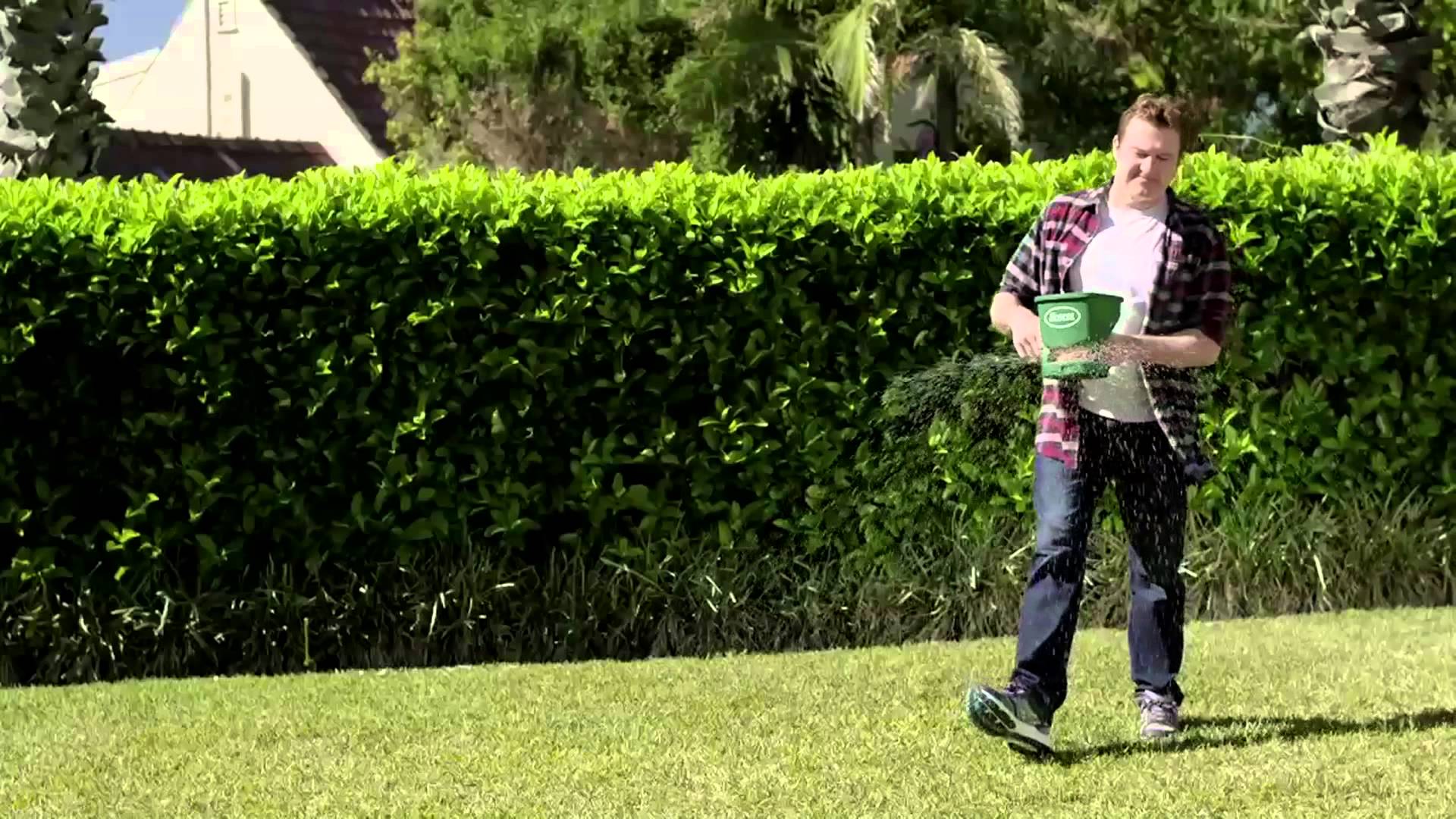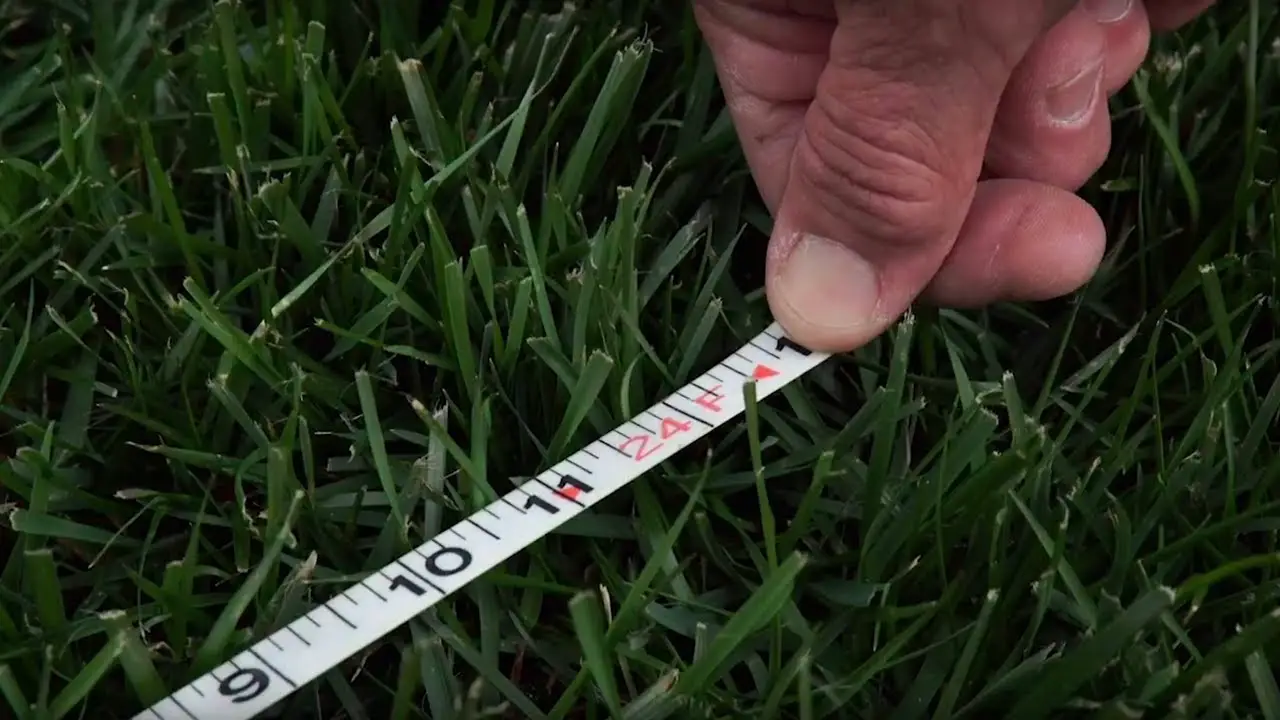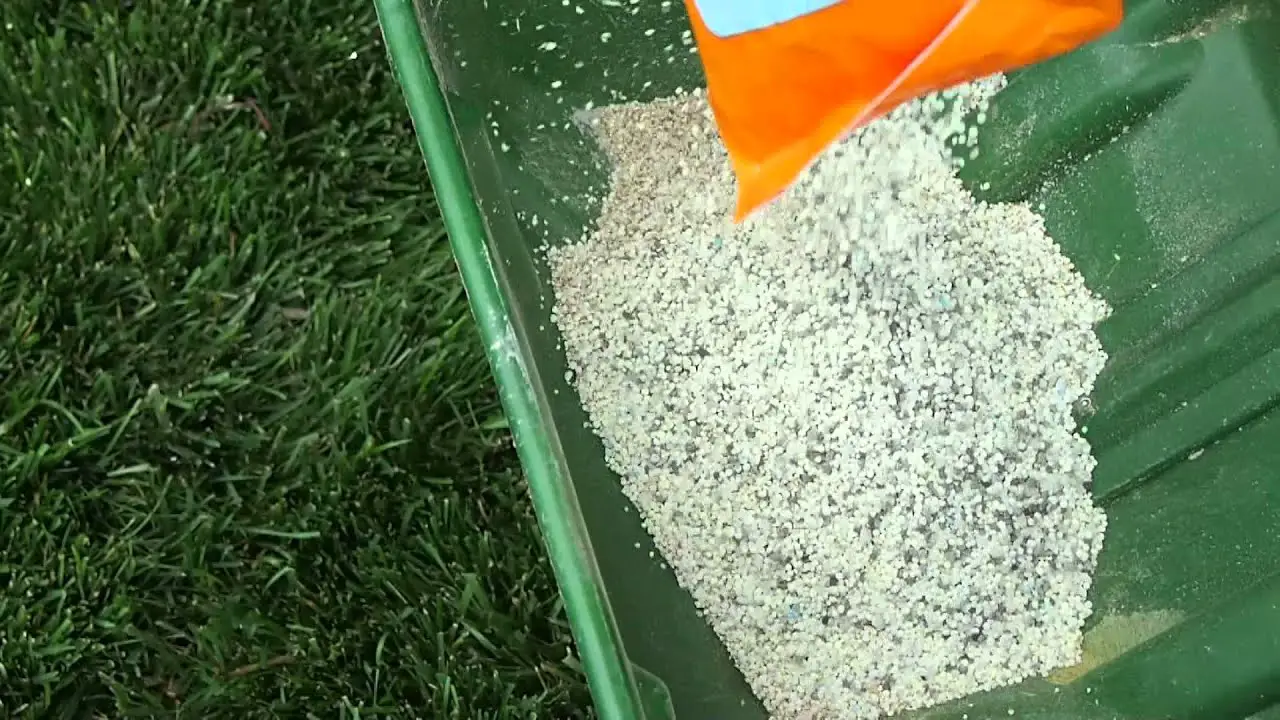How To Tell If Your Lawn Needs To Be Aerated
Testing to see if your Minnesota lawn needs aeration is a simple process. All it takes is a screwdriver and a few minutes of your time. Simply follow these steps:
When To Fertilize Lawn
Knowing when to fertilize your lawn depends on how often you plan to apply it. If you fertilize once a year, do it around Labor Day thats when lawns absorb the most nutrients. For biannual fertilizing, add a second application the middle of October.
There are exceptions to this timeline depending on climate and soil types, so adjust if your lawn is not retaining enough nutrients. In the spring, if you feel the need, spread a little fertilizer to help the greening process.
When And How To Fertilize New Grass
If you’re starting a new lawn from seed, sod or plugs or you’re doing bare lawn spot repair a starter fertilizer helps grass get the perfect start. Unlike established lawns, new grass benefits from extra phosphorus, an essential plant nutrient that supports strong, deep roots. Some states only allow phosphorus-containing lawn fertilizers on new grass, so check with your county extension office if you’re unsure.
On fertilizer products, phosphorus is the middle number in the N-P-K ratio usually “0” in normal lawn fertilizers. But with Pennington UltraGreen Starter Fertilizer 22-23-4, you get an ideal ratio of nitrogen, phosphorus and potassium, plus other essential lawn nutrients, including iron for deep green color. This premium fertilizer blend starts feeding new grass immediately and keeps feeding it for up to three months.
Always follow guidelines for the best time to plant grass seed for your region and grass type, then fertilize accordingly. For seed or plugs, apply fertilizer with a regular lawn spreader before you plant. If you’re starting a lawn with sod, fertilize after your sod is in place.
With any new lawn area, avoid using crabgrass preventer fertilizers or weed & feed fertilizers within four weeks before planting time. After seeding, wait until your new grass gets established and you’ve mowed your lawn at least three times.
Weed & feed fertilizers kill tough weeds and feed your lawn.
You May Like: How Much Does Trugreen Cost Per Year
Spring Lawn Fertilizer Timing
Step 1: If you are planning a simple 4 Step plan, be it from Jonathan Green or Scotts, your first application of spring fertilizer will also contain a crabgrass pre-emergent. This means you need to get this applied before your soil temps hit 55 degrees. So target early spring .
Step 2: The second spring application is generally a weed-and-feed fertilizer. Step 2 is applied 6-8 weeks after Step 1. The timing here is around Memorial Day or approximately two-to-three weeks before the first day of summer.
Grow With Kare: Lawn Care Calendar

GOLDEN VALLEY, Minn. There are so many questions on our Grow with KARE Facebook Page about what to do with your lawn right now. So heres a timeline of when to do what.
If and only if your lawn is dry, you can lightly rake. But typically this does more damage than good this time of year.
The most popular topic right now is crab grass.
Crab grass germinates when the soil temperature reaches 55 degrees for 24 to 48 hours. This is typically mid-April to mid-May but will vary depending on your specific location. You want to apply the pre-emergent BEFORE the crab grass germinates. A good rule of thumb is to do that when the forsythias are almost done blooming and just before the lilacs bloom. And remember, you only need to do this if you actually have crab grass.
Post-emergent crab grass control can be applied in late May through early July after the crab grass has already started growing.
Laying sod is a job for May or June. The fall months are also a good time to lay sod.
Seeding the lawn is okay to do in May to June, but waiting until August or September if you can is a better option. Same with fertilizing and aerating. Fertilizing too early is a common mistake and forces the grass to grow in a time when it should be dormant.
Broadleaf weed control is also best saved for September through October but May through June is an okay time to do it.
Dethatching is on the fall to do list, not spring.
Also Check: Killing Creeping Charlie
When Should I Fertilize My Lawn In Spring And Fall
As well as knowing how often to apply fertilizer, its also key to know when to apply the fertilizer. To answer this question, it is recommended that you should always follow the instructions found on the label of your chosen fertilizer. However, following the general tips below will help you decide when to fertilize the lawn:
- Apply when the grass is actively growing.
- Apply when the soil is damp and the grass is dry.
- Apply when the grass is frost-free.
- Dont mow the lawn 3 days before or after applying the fertilizer.
Applying fertilizer outside of the period stated on the instructions as well as the guide above will run the risk of damaging your lawn so it is important to pay attention to this.
Dont apply fertilizers to your lawn during the winter months as the grass is dormant and will not achieve any better results. Applying fertilizer in the winter will increase the chance of polluting waterways by excessive run-off of the nutrients into nearby streams.
How Often To Fertilize Lawn
Over-fertilizing is a thing. If once a year is right for your lawn, stick with that and dont get carried away. Fertilizer can be a valuable tool to keep a lawn healthy, dense and looking great, but it can also create environmental concerns if not used responsibly. Follow the label instructions on your fertilizer as each product has unique specifications and needs.
You May Like: Does Lowes Rent Tillers
How Often Should Minnesota Lawns Be Aerated
There is no catch-all aeration schedule for Minnesota lawns. Whether youre in Rochester, Minneapolis, or further north in Duluth, it all depends on how quickly your soil becomes compacted. There are many factors behind this, from soil composition to the amount of traffic your lawn gets. It may not seem like much, but human and pet traffic can go a long way to compacting the soil.
Lawns should be aerated as often as the soil fails the soil test described above. Although aeration may not be necessary on a yearly basis, check the soil once per year to see if your lawn is in need of aeration.
When To Schedule Lawn Maintenance
It is important to schedule your lawn care maintenance during times that match the life cycle of the turfgrass.
- Do not add fertilizer too early in the spring. This may encourage the grass to grow during a time when it should be slow or dormant.
- Do not spray to control weeds when temperatures are warm. This increases the likelihood of damaging the lawn.
- Do not fertilize in hot mid-summer months. This can cause irreversible damage to your lawn.
- Crabgrass doesn’t develop until late spring or early summer, so don’t apply herbicide used to prevent pre-emerging crabgrass in the fall.
See Water-saving strategies for home lawns for information on how and when to water.
Recommended Reading: Best Time Of Day To Water Lawn In Colorado
When Should I Fertilize My Lawn In The Spring
Youre prepared your lawns for winter, waited patiently for warmer temps and longer days to roll around, and now finally jumping into your spring lawn care. So now you may be asking yourself, When should I fertilize my lawn in the spring?
Its a common question, but for us avid lawn phixers, it may not be as cut and dry. Theres a lot of outstanding questions that we should answer first before we start applying fertilizer to our lawns this spring.
Springtime is when your grass is actively growing, so youll want to make sure you account for this in your annual fertilizer schedule. Feeding your lawn in the spring will help developer stronger, deeper roots and promote a green and healthy lawn. Providing enough food for your turf is key to help it get through the hot and stressful summer months.
Page Contents
Plant A Garden For Rain And Wildlife
Spend less time mowing, and more time enjoying your garden. Replacing parts of your yard with native perennials lessens the need for mowing, watering, and chemicals. It also provides habitat and food for birds and butterflies. Planting trees in your yard can reduce heating and cooling costs.Get to know your garden site. For example, how long is it exposed to sunlight? What is the soil type? Does the soil hold moisture well? What will you keep and what will you take out? How will your plants influence wild native plants, or be influenced by nearby weedy exotics? Answering these questions will help you better plan your garden and landscaping to fit your needs and budget.
- Learn how to design a native garden from Blue Thumb.
Don’t Miss: How To Clean Lawn Mower Carburetor
Why Should You Hire An Expert For Lawn Fertilization Services
With so many products on the market, lawn care and fertilization may seem like an easy do-it-yourself task. In reality, it can be difficult to do correctly.
The first question many homeowners ask is: When should I fertilize my lawn in Minnesota? Doing 4 to 5 incremental fertilizer applications throughout the growing season is optimal. The first application, typically done in April or May, is the most important to encourage vigorous growth. Early summer fertilizer can be combined with crabgrass preventive treatments as well. Over the warmer summer months, we recommend 2 to 3 maintenance applications, along with careful attention to watering. The final application is done in the fall.
Timing isnt the only important consideration. The type of fertilizer used makes a big difference to the health of your yard. During our lawn fertilization services, our experts use only the best slow-release, granular products that wont burn your lawn, or stimulate the grass to grow too quickly.
Our technicians are highly trained to avoid problems homeowners often encounter, including:
- Using too much, or the wrong type of fertilizer
- Uneven distribution of fertilizer
- Applying more than the lawn requires and is able to use
- Applying fertilizer when the lawn doesnt need it
Determining The Best Times To Fertilize

Homeowners who prefer organic fertilizing methods might do a single “turf-builder” application in the early fall to build root systems. In the spring and summer, most may omit all fertilizers and rely on the nitrogen from mulched grass clippings to feed their lawn.
Homeowners using traditional fertilizer might want to apply two or three light applications per growing yearone in the spring, one at midsummer in regions where it is necessary, and one “turf-builder” application in the early fall.
The actual timing depends on your region and the type of turf grasses you have. For information on the best recommendations for your area, contact an expert at a local garden center or reach out to the nearest cooperative extension office.
Once you have figured out the best time, try to plan the fertilizer application with a short period of rainfall. If not, when you apply the fertilizer, you will need to supply your lawn with at least a quarter-inch of water. However, do not apply fertilizer before a massive storm. A rainstorm increases the risk of fertilizer nutrients flowing into storm drains and streams.
Also Check: Oil Drain Tube For Craftsman Riding Mower
How Often Do You Have To Wait Between Fertilizer Applications
Fertilizers with a higher nutrient content will mean that you need to wait longer between applications in comparison to lawn fertilizer with a lower nutrient content. Some fertilizers can be applied once every four weeks whereas some you will need to wait as long as twelve weeks before you feed your lawn.
Knowing how long you will need to wait between applications will differ between the specific lawn fertilizer you have purchased.
A good tip to ensure that you dont over-fertilize your lawn is to make a note on a calendar the date you applied the lawn food. Read the instructions on your chosen fertilizer to see when the manufacturer recommends reapplying the feed. Then workout when the feed should be reapplied and add this date to your calendar.
Alternatively, set a reminder on your smartphone to prevent over-feeding.
The recommended frequencies of fertilizer application can be found in the tables further down in this article.
When To Apply Popular Uk Fertilizers
Below is a table detailing how often to apply popular U.K. lawn fertilizers such as Miracle-Gro Evergreen and Westland. Please note that some of the fertilizers below contain weedkiller. These can be applied to any type of grass.
Please note that the table below includes Amazon Affiliate links.
*NPK = Nitrogen, Phosphorous, Potassium
Read Also: Best Fertilizer For Colorado Lawns
When To Aerate Lawn In Minnesota
Early fall, between mid-August and late-September, is the best time to aerate your lawn in Minnesota. This timing allows your lawn to take advantage of the decompacted soil, and have a strong fall growth spurt. It also sets your grass up to easily survive winter dormancy and have an incredible spring green-up.
Avoid spring aeration because this invites invasive weeds. It also doesnt take advantage of the strongest growth period of grasses planted in Minnesota, which is fall. If you want to serve your yard best, aerate in autumn.
Picking The Right Fertilizer
Picking the right fertilizer depends on your lawn type and your end goal is. If you want to make your lawn greener and healthier, a product like The Andersons 16-0-8 Fertilizer with Humic DG is great for you. It contains methylene-urea that will give your lawn an even feed over eight to 10 weeks. Its also safe for pets.
Don’t Miss: Best Weed Control For Creeping Charlie
What Fertilizer To Use
There are many fertilizers available, so sometimes it can be difficult to select the right one. For late summer and early fall application, you should use a fertilizer that delivers its nitrogen in slow-release form. It can also be labeled as water-insoluble or controlled-release fertilizer. These are more effective in providing the nutrients required at the correct rate for late summer and fall. You may also want to consider a fertilizer that is specialized for the crops you are growing.
Bonus: You can also build soil fertility by adding compost. Compost can help improve the fertility and texture of the soil. Just add 1 to 2 inches to the top of the soil and work it in about 6-8 inches.
See our Garden Maintenance Schedule to learn more about when you should fertilize your lawn and garden!
When Should I Aerate My Lawn In Minnesota
4.1/5When to aerateTheto aeratethe lawn
Apply crabgrass pre-emergent in early to mid-May if possibleAlthough it is tempting to apply your first fertilizer application shortly after the snow melts in April, this is often too early and the pre-emergent will not last long enough to be effective late into May and June when it is needed most.
Also Know, when should I apply Winterizer to my lawn? Winter fertilizers are usually applied in late October or early November to cool-season lawns. To take full advantage of the effects of winterizer fertilizer, you should also apply fertilizer to your lawn in early September. The early fall feeding stimulates root growth.
Also question is, when should I seed my lawn in Minnesota?
Many people plant grass seed in spring. This may be an acceptable time to plant grass in cool weather states like Minnesota, but early fall is a better season to plant according to the University of Minnesota, and the ideal time is from mid-August to mid-September.
How do I know if my lawn has too much thatch?
Walk on the lawn to see if it feels firm or spongy.The first thing that gives you a hint at whether or not your lawn needs to be dethatched is the feel of it. Walk around for awhile and see if the ground feels firm. If it feels spongy, or almost bouncy, that’s a sign that the thatch has gotten too thick.
Recommended Reading: How To Get Rid Of Geese On Lawn
When Should I Fertilize My Lawn In Minnesota In Spring
Late summer and early fall are the best times of year to fertilize your garden and lawn. According to the University of Minnesota, early spring applications of fertilizer can make your lawn look nice from the surge of top growth, but it ultimately depletes the plants energy reserves.
When should I apply crabgrass preventer in Minnesota?
Apply crabgrass pre-emergent in early to mid-May if possible Although it is tempting to apply your first fertilizer application shortly after the snow melts in April, this is often too early and the pre-emergent will not last long enough to be effective late into May and June when it is needed most.
Can You Aerate Your Minnesota Lawn In Spring

Aerating your Minnesota lawn in spring is not recommended. Many lawn care services in the region advise against it because it simply doesnt set your lawn up for success. Some of the downsides of spring aeration are:
- Grass will experience a smaller boost in growth compared to fall.
- Weed seeds exposed by aeration will sprout.
- You may have to spread herbicides to stop invasive weeds, adding to lawn care costs.
Similar to spring, avoid summer aeration. Cool-season grasses grow slowly in summer, and the holes created by a good aeration machine may cause the soil to dry out during hot daytime hours. This can harm your grass or necessitate extra watering.
Don’t Miss: How To Get Rid Of Geese On Lawn
